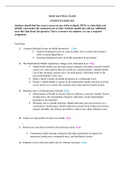NURS 442 FINAL EXAM
STUDENT EXERCISE
Students should find the correct answer in one of the textbook, PPTS, or video links and
identify what makes the statement true or false. Students should also add any additional
facts they find about the question. This is a resource for students, it is not a required
assignment.
True/False
1. Systems thinking focuses on health promotion. False
Systems thinking focuses on cause & effect, how an indiv/unit interacts
with a system/organization
Upstream thinking focuses on health promotion & prevention
2. The Health Belief Model emphasizes change at the individual level. True
Health belief model says the main reason someone will make a positive health
action is b/c they believe they are at risk for a certain disease. Includes health
cues (Quit smoking commercials, Got milk poster), Individual looks at the
perceived benefits vs the cons
Milio’s theory focuses on health promotion at a community level
Pender’s Health Model is similar to the health belief model, but does not look
at risk factors as a reason why someone may make positive health actions
3. Mortality rate is a Determinant of Health. False
Determinants of health are factors that can influence a person’s health. Factors
include stress, the environment, finances, education, social status/stigma
(prejudice), and nutrition
Mortality rate is a health indicator. Health indicators give an overview on a
community’s health status. Health indicators include level of physical activity,
obesity mortality rate, disease prevalence, tobacco use, other substance use)
4. Clients are responsible for their own health. True
‘:
5. Beneficence maximizes benefits and minimizes harm. True
Community health nursing is based on the ethical principles of respect for
autonomy, beneficence, nonmaleficence, and distributive justice
6. Endemic occurs when the attack rate of a disease increases. False
, Endemic is present when a disease or condition is present in moderate levels
Attack rate is the # of xspeople exposed to a specific agent who developed the
disease
7. Tuberculosis is an example of waterborne transmission. False
TB is an example of an airborne transmission. Other airborne transmission
include pertussis, measles, SARS, influenza, and chickenpox
Waterborne Transmission – Cholera, typhoid fever, bacillary dysentery, and
giardia lamblia
Foodborne transmission – Norovirus, Hepatitis A, E.coli, Trichinosis, &
salmonella
Food intoxication – Toxin produced in food via bacterial growth, chemical
contamination, or disease producing substances (Clostridium botulism, Staph
aureus)
Direct Contact – HIV/AIDS, STIs (Chlamydia, Gonorrhea, Syphilis, HPV, HSV)
Hep B, C, D, infectious mono, enterobiasis (pinworms), impetigo, lice, and
scabies
8. Lead is an example of air pollution and a toxin. True
Toxins: Lead, pesticides, mercury, solvents, asbestos, & radon
Air pollutants: Carbon monoxide, particulate matter, ozone, lead, aerosols, nitrogen
dioxide, sulfur dioxide, & tobacco smoke
Water pollutants: Wastes, erosion after mining or timbering, & run off from chemicals
added to the soil
Contamination: Food & food products with bacteria, pesticides, radiation, and
medication (Growth hormones or antibiotics)
9. Pesticide exposure causes anticholinergic symptoms. False
Exposure to pesticides cause cholinergic symptoms/bronchospasms –
Bradyarrhythmia, bronchorrhea, & muscle weakness
Objective signs: Confusion, irritability, muscle weakness, twitching,
nasopharyngeal irritation, vomiting, rash
Subjective signs: Headache, dizziness, dyspnea, nausea, abdominal cramps, poor
concentration, & eye irritation
10. Radon is tasteless. True
Radon is a toxin that is odorless, colorless, and tasteless. It affects indoor air quality. It is
the 2nd leading cause of lung cancer
11. Macroeconomics focuses on aggregates. True
Microeconomics focus on individuals
, Macroeconomics is when the government plays a role in the direct health care of
aggregates
12. The CDC sets the world standards for antibiotics. False
The WHO sets the standards for antibiotics
13. A secondary caregiver in homecare has intermittent responsibilities. ______________
14. Palliative care eliminates pain for chronic disease. True
You do not have to be on hospice to receive palliative care
Hospice care is given to those who have 6 months or less to live & bereavement
services are given to the family for one year after the client’s death. The main
focus is to enhance quality of life and relieve symptoms associated with the dying
process
15. Relationships are part of the structure when assessing a community. False
Community assessment components include the following
o Demographics (Distribution, Mobility, Density, Census data)
o Biological factors (Health & disease status, genetics, race, age, gender,
causes of death)
o Social factors (Occupation, martial status, education, income, crime rates,
recreation, industry)
o Cultural factors (Ethnohistory, hierarchy & roles, language, religion &
spirituality, values, customs, norms)
o Place or Environment (Physical features – geography, housing, &
locations of health services. Environmental factors – climate, pollutants,
topography)
o Social Systems (Health system/health services, economic system,
religious systems, welfare systems/resources, political/legal system,
recreational system, transportation, communication factors
16. A limitation of informant interviews in data collection is built -in-bias. True
Informant reviews – Direct discussion with community members for the purpose
of obtaining ideas & opinions from key informants. Can be formal, informal, or
authoritative knowledge.
o Strengths: Min. cost, participants serve as future supporters, offers insight
into beliefs & attitudes of community, reading/writing not required,
personal interaction can elicit more detailed responses
o Limitations: Built in bias, meeting time and place
Community Input – Open public meeting
o Strengths: Opportunity for community input, min. cost




